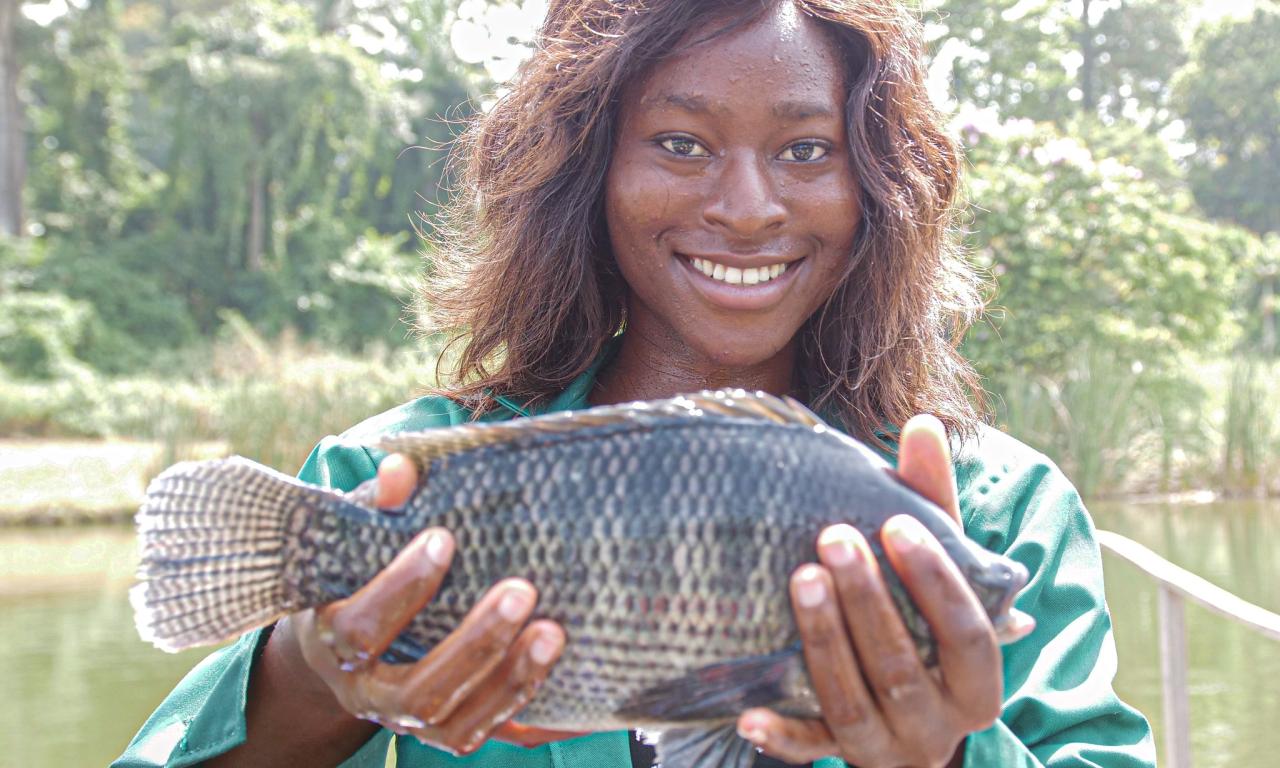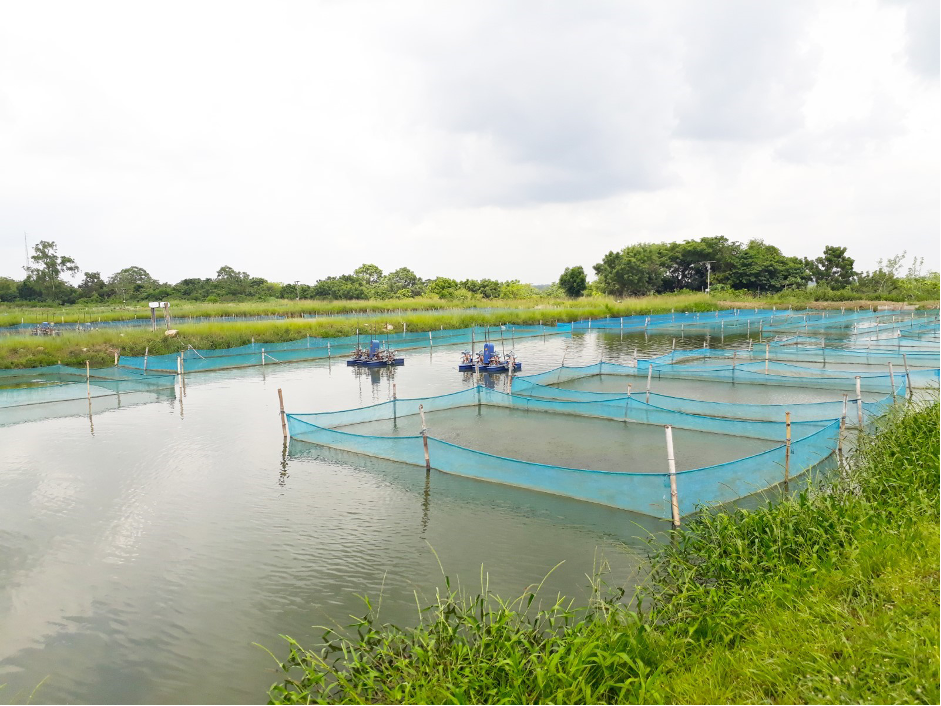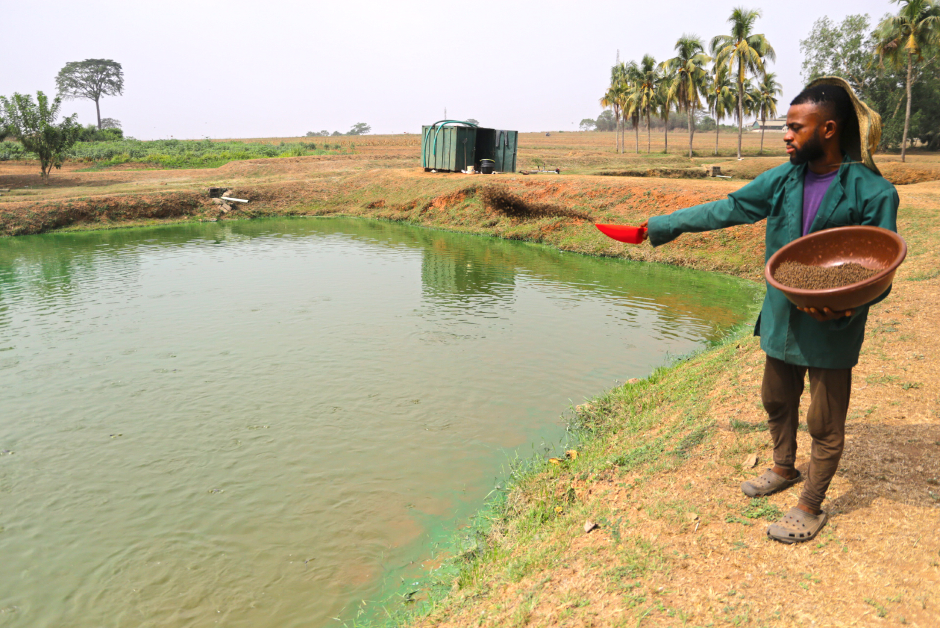
- Aquaculture in Nigeria can be leveraged to increase domestic food production and reduce the country’s dependence on costly fish imports
- Yet a newly published scoping study has demonstrated that inadequate supply chains and a lack of farming inputs currently constrain the sector’s capacity
- Investments in aquaculture supply chains will nourish and uplift the poor and vulnerable, especially women and youth
For Nigeria’s rapidly growing population, the aquaculture sector offers new opportunities for sustainable livelihoods and nutritious diets. As aquatic food consumption continues to rise, the Nigerian aquaculture industry—the second largest in Africa—looks to innovate to keep up with surging demand and nourish a nation.
Local aquatic food systems, which comprise fisheries, aquaculture and related supply chains, are increasingly recognized for their ability to provide sustainable, healthy diets and decent work. Although Nigeria’s coastal capture fisheries are strained, aquaculture can be leveraged to fill in the gaps and provide jobs in the fisheries sector. From fish harvesting to processing and trading, these diverse income-generating activities have the potential to uplift rural communities.
Recognizing her country’s growing appetite for aquatic foods, along with the economic potential of the industry, Aderinsola Olubunmi Agbato, the executive of B-Spice Farms in Oyo State, opened a fish-based product business five years ago. She processes locally farmed catfish to develop value-added retail products like dried fish powder, fish oil, fish spice and packaged fish snacks. Through processing, Agbata is able to extend the shelf life of fish, earn income and have a dependable supply of nutritious food.
“Fish processing provides about 40 percent of my family income. I also eat the fish I process, and it is always part of every meal I prepare, especially in my baby’s daily diet,” said Agbata.
Fish provide vital micronutrients during the first 1000 days of life, enabling optimum cognitive and physical development in young children like Agbata’s. While many nutritious animal-source foods are limited in supply and expensive in low- and middle-income countries, fish tends to be more affordable and available.
Though fish is the most frequently consumed animal-source food in Nigeria, their fish consumption rate remains below the global per capita average. Fish consumption in Nigeria is measured at 13.3kg per person per year, while the world’s average is around 21kg.
There is ample room to increase fish consumption, especially among vulnerable communities, if the nation were to boost its smallholder aquaculture sector, explained Sunil Siriwardena, WorldFish’s program coordinator for Nigeria.
“There is a lower fish consumption rate among resource-limited and marginalized communities in Nigeria due to the notable supply-demand gap. Local fish production is failing to meet demand, which leads to costly foreign fish imports that put these nutritious foods out of reach of the vulnerable,” said Siriwardena.
To equitably transform food systems and improve food and nutrition security across the African continent, Nigeria’s emerging small-scale aquaculture sector offers a path forward. By enhancing the capacity of domestic and regional food production systems, key nutrients can become more accessible and affordable to the rural poor.
With support from the Bill and Melinda Gates Foundation (BMGF), WorldFish conducted a comprehensive study to fill critical knowledge gaps and inform future investment decisions that facilitate the inclusive growth of Nigeria’s aquaculture sector. The scoping study reviewed the current status of Nigerian aquaculture and outlined the challenges and opportunities to increase fish consumption across sub-Saharan Africa.
“The federal government appreciates and values the collaborative work between WorldFish, the Bill and Melinda Gates Foundation and the United States Agency for International Development, in partnership with the Nigerian Federal Department of Fisheries and Aquaculture, to assess the contribution of fish and other aquatic foods to the people of Nigeria and to identify the bottlenecks, challenges and opportunities for this valuable resource,” said Nigeria’s Minister of Agriculture and Rural Development Mohammad Mahmood Abubakar.
The study concluded that, through targeted interventions and investments in supply chains, domestic fish production can be increased to sustainably enhance food, nutrition and economic security.
“This comprehensive study comes at a crucial moment as the Nigerian government is looking at developing aquatic food systems to nourish our growing nation and provide economic opportunities for our citizens while respecting environmental health,” said Abubakar.
Enhancing local production to meet demand

Domestic food production remains relatively low across Africa, and food imports are a significant but necessary expenditure for many sub-Saharan nations. The problem is particularly prevalent when it comes to fish and aquatic foods. Despite being richly endowed with aquatic resources, Africa accounts for 11 percent of global aquatic food imports by volume.
Though Nigeria is the second largest aquaculture producer in Africa, the country’s aquaculture industry is constrained by a lack of resources and technical knowledge. Due to mounting overhead costs, aquaculture production in Nigeria decreased between 2016 and 2018, largely attributed to a spike in the price of commercial fish feed and currency deflation.
Unable to sustain the population’s demand for aquatic foods, Nigeria has become Africa’s largest importer of fish. In 2018, approximately 45 percent of the country’s fish supply was imported, leading to a trade deficit of nearly one billion USD.
In the scoping study, WorldFish Foresight Model projections predicted that the fish supply-demand gap in Nigeria will further widen over the coming decades without intervention. Marine capture fisheries are already operating at maximum capacity; surging demand will have to be met either by additional imports, aquaculture or artisanal inland fisheries.
“Pursuing a strategy to lessen dependence on fish imports while increasing fish supplies through aquaculture growth is the most likely way to meet future fish demand and improve national economic outcomes,” said Rohana Subasinghe, WorldFish’s technical lead on the project.
In order to build the capacity of the aquaculture sector, the scoping study determined that access to high-quality inputs must be improved. In a preliminary survey of fish farms in eight states across Nigeria, the majority of farming households responded that the lack of fingerlings, or the immature fish used to stock ponds, and the price of commercial fish feeds were the primary barriers to tilapia farming.
Hatcheries, dedicated to the breeding, hatching and rearing of fish, are tasked with providing fish fingerlings to farmers. However, the scoping study concluded that the country’s hatchery production system is currently incapable of supplying enough fish to smallholders prepared to enter aquaculture production.
The study determined that neither the quantity nor genetic quality of fish seed, or fertilized fish eggs, available in the country were sufficient to support aquaculture growth. Moreover, commercial fish feed was found to be too expensive for most smallholders.
“Inbred stock (from a lack of genetic diversity) and the high cost of fish feeds are the biggest challenges I face as a fish farmer in Nigeria,” explained Marcus Adeniyi, general manager of the Ijebu Development Initiative on Poverty Reduction (IDIPR) fish farmer’s cooperative.
In a bid to make commercial fish feed more accessible, the report’s authors suggested that corporate feed manufacturers invest in using locally available nutrient-rich leftovers like cassava and banana peels to reduce production costs and food waste and loss simultaneously.
Increasing access to quality feed and seed can make fish farming a more accessible enterprise to average Nigerians, encouraging more people to engage in the sector and improve health and nutrition across the country.
Supporting inclusion and empowerment

While its full potential remains unrealized, the Nigerian aquaculture sector is already supporting socioeconomic inclusion.
About half of post-harvest aquaculture activities, including fish processing and retail, are performed by women and 35 percent by youths. Therefore, investments to enhance fish supply chains will likely deliver economic benefits to diverse supply chain actors and demographic groups.
With sufficient resources and fully developed supply chains, aquaculture substantially increases smallholder income, especially in rural communities with limited economic opportunities. For instance, smallholder catfish farmers in Nigeria were found to have higher per hectare net incomes than agriculture farmers.
“Over the next five years, we will focus on developing catfish and tilapia supply chains that empower women, create jobs and provide nutritious food to regions far from urban markets,” said Siriwardena. “The scoping study showed this can largely be done with investments in genetic improvements and private sector partnerships to enhance feed and seed production.”
For equitable outcomes, the study emphasized the need to pay special attention to dry, rural northern regions. The country’s aquaculture production is centralized around favorable climates in southern provinces. Unmet market demand in the north requires additional investment to develop cold chains that extend fish availability and access to households far from production sites.
“Fish supplies ultimately must be increased and supply chains aligned to make fish affordable and accessible to the rural poor, with special emphasis on remote northern states,” said Subasinghe.
Promoting the use of fish-based products, like those that Agbato develops and feeds to her children, would improve access to fish—small fish can be dried and ground into powder, circumventing the need for cold storage, and scattered over cereal foods like rice and noodles to increase their nutritional value. Alternatively, small fish may be processed into nonperishable snack foods that can be widely distributed.
As Nigeria’s population expands into the foreseeable future, the country is looking towards aquaculture to provide meaningful work and nourish a nation—this can be achieved with the proper external support coupled with the ingenuity of local entrepreneurs like Agbato.
